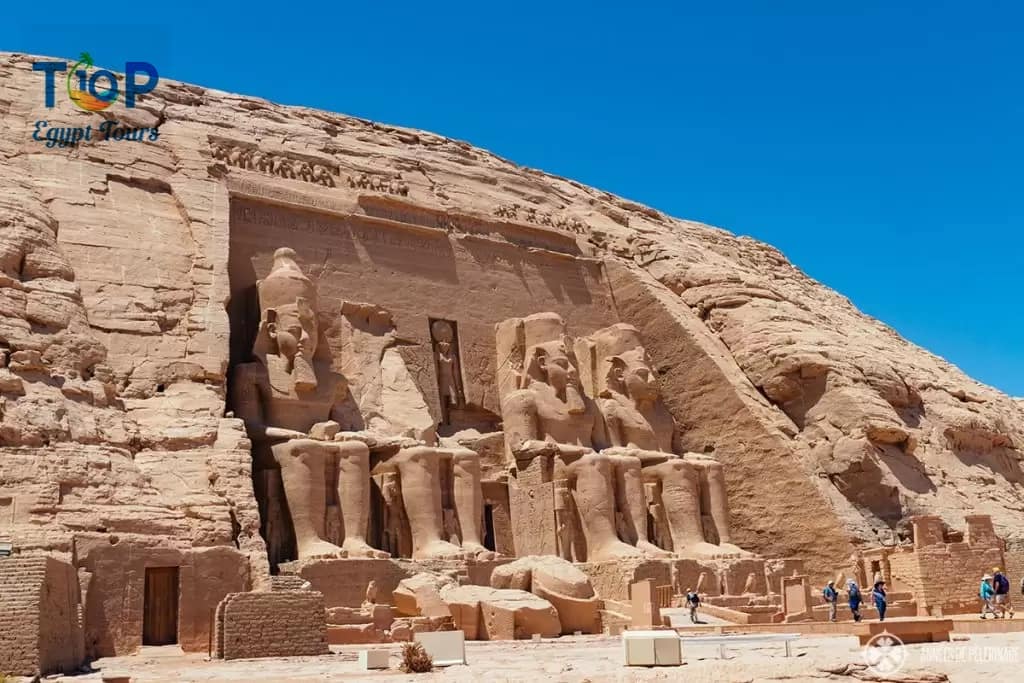The Temple of Ramses II welcomes to the heart of ancient Nubia, where history unfolds in magnificent stone structures, telling tales of power, grandeur, and cultural richness. In this journey through time, we delve into the awe-inspiring Temple of Ramses II, a monumental symbol of Nubian greatness that stands proudly in the Egyptian landscape.
I. Historical Context Of The Temple of Ramses II:
To truly appreciate the Temple of Ramses II, one must understand the historical context in which it was built. Ramses II, also known as Ramses the Great, was one of Egypt’s most formidable pharaohs, reigning from 1279 to 1213 BCE during the New Kingdom period. His reign was marked by military prowess, architectural marvels, and a commitment to leaving an indelible mark on the landscape of ancient Egypt.
II. Location and Design:
Situated on the west bank of the Nile, in the southernmost part of ancient Egypt, the Temple of Ramses II at Abu Simbel is an engineering feat that continues to captivate visitors today. Carved directly into the mountainside, the temple complex consists of two main rock-cut temples: the Great Temple of Ramses II and the smaller Temple of Hathor dedicated to his beloved queen, Nefertari.
The Temple of Ramses II, also known as the Ramesseum, is a magnificent architectural masterpiece that stands as a testament to the power and grandeur of the ancient Nubian civilization. Located in the city of Luxor in Egypt, this temple was built during the 19th dynasty by Pharaoh Ramses II, one of the most celebrated rulers of ancient Egypt.
The temple’s design is a fusion of traditional Egyptian and Nubian architectural styles, reflecting the cultural exchange that took place between these two civilizations during Ramses II’s reign. The temple’s facade features colossal statues of Ramses II, each standing over 16 meters tall, making them some of the largest statues ever created in ancient times.
The interior of the temple is equally impressive, with intricate carvings and reliefs depicting scenes from Ramses II’s life and reign. The walls are adorned with vivid colors and gold leaf, adding to the temple’s opulence and grandeur. The temple’s central hall, known as the Hypostyle Hall, is particularly noteworthy, with 134 massive stone columns arranged in 16 rows.
Today, the Temple of Ramses II stands as a testament to the rich cultural heritage of ancient Egypt and Nubia. It continues to attract visitors from around the world who come to marvel at its beauty and historical significance. The temple has also been designated a UNESCO World Heritage Site, recognizing its cultural and architectural importance.
Solar Alignment: A Testament to Precision:
One of the most remarkable aspects of the Temple of Ramses II is its solar alignment. Twice a year, on February 22nd and October 22nd, the sunlight penetrates the inner sanctum to illuminate the statues of Ramses II and the gods seated within. This phenomenon highlights the ancient Egyptians’ advanced knowledge of astronomy and their ability to integrate celestial events into their architectural designs.
In a feat of modern engineering and international cooperation, the entire Abu Simbel complex was relocated in the 1960s to avoid submersion due to the construction of the Aswan High Dam. This monumental effort, led by UNESCO, preserved the temples for future generations and solidified their status as a UNESCO World Heritage Site.
As you stand before the colossal statues of Ramses II, the significance of the Temple of Ramses II becomes palpable. It’s not merely a structure carved in stone but a testament to the enduring power and cultural richness of ancient Nubia. The awe-inspiring grandeur of this temple invites travelers from around the world to immerse themselves in the mystique of Egypt’s past, discovering the stories etched into its very bedrock.
Browse our complete list of Egypt tours Click Here



Comment (0)